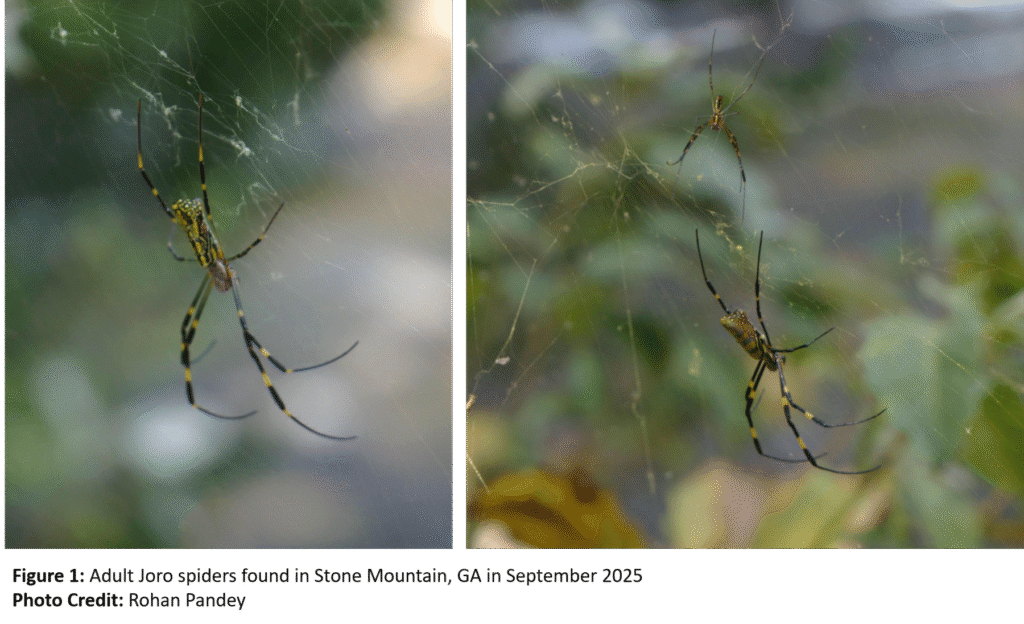Joro spiders (Trichonephila clavata) are hard to miss. With females growing up to 4 inches in length, these brightly colored arachnids are notorious for creating massive webs in urban environments throughout the Atlanta metro area. As fall approaches, you might be noticing higher numbers of mature spiders throughout the county. Native to East Asia, this species of orb-weaving spider is believed to have arrived in the United States on shipping containers. Joro spiders were first confirmed in Georgia in 2014 (Hoebeke et al., 2015) and have since expanded their range into surrounding states. It is hypothesized that they could eventually occupy much of the East Coast (Hataway, 2022).

Initially, the introduction of this non-native species triggered widespread concern. This reaction was understandable considering the damaging effects of other invasive species in Georgia, like spotted lanternfly, kudzu, and emerald ash borer. Joro spiders exhibit unique traits that raised alarm: female spiders are exceptionally large, and their webs are significantly stronger than related spiders. In fact, the first known case of a bird being fully supported (perching, not caught or tangled) by a spider web was on a Joro web (Schronce & Davis, 2022).

Their heart rate is 77% higher compared to their relative, the golden silk spider (Trichonephila clavipes) (Davis & Frick, 2022). While the golden silk spider is confined to the southeastern united states, the Joro spider’s high metabolism allows it to better tolerate freezing temperatures. This could potentially result in them expanding their range further north. Young Joro spiders are also capable of a mechanism called ballooning, where they create parachutes made of silk to travel to new locations by wind. This ability allows them to spread rapidly. Their superior freeze tolerance, combined with this dispersal method, made early concerns that they would outcompete native species throughout the East Coast very real. But are they as much of a threat as we initially thought?
Impact on Human Health and Safety
Given their size and rapid spread, one might assume that Joro spiders are an aggressive, competitive species. Surprisingly, though, we’ve found that Joro spiders are remarkably docile. Despite frequently colonizing human structures, Joro spiders are often reported to stay out of people’s way. Like most spiders, they have venom, but it’s not harmful to humans and their fangs are unlikely to be capable of piercing human skin (Hataway, 2023).
A recent study from the University of Georgia found that, when disturbed, Joro spiders exhibit a startle response that causes them to freeze (Davis & Anerao, 2023). The reason behind this reaction is unclear, but it is hypothesized to be a survival tactic similar to a fight-or-flight response. While other arachnid species are known to display this behavior, the response in Joro spiders is far more intense, causing them to remain frozen for over an hour on average. This behavior may contribute to their success in urban settings by increasing their ability to tolerate human interactions and disturbances.
The main reason people dislike Joro spiders is simply because of the size and placement of their webs, since they can reach up to 10 feet in diameter and are often built in inconvenient locations, across porches, paths, and entryways.
Impact on Native Species
The impact of Joro spiders on native species remains a major topic of debate. Joro spiders are generalist predators, feeding on a wide range of insects such as cockroaches, wasps, beetles, and other spiders. This generalist feeding behavior suggests they may overlap with the ecological niches of many native spiders, potentially leading to competition. However, there is currently no conclusive evidence of significant ecological impact on native species since their introduction. Some evidence suggests that native orb-weavers may exhibit lower population diversity in areas with high densities of both Joro spiders and humans (Nelson et al., 2023). Although, this could easily be attributed to Joro spiders occupying habitats with high human activity that native species avoid, filling a new niche. It has also been suggested that, due to their large body size, Joro spiders may be consume prey that smaller native orb-weavers can’t. (Nelson et al., 2023).
Despite these preliminary findings, research on the ecological effects of Joro spiders is severely limited. While their current impact appears minimal, it would be naive to dismiss potential future consequences at this early stage. Although Joro spiders have been present in Georgia for over 15 years, they are still considered a newly established invasive species, and history has shown that the true effects of invasives are often revealed with time.
To aid with monitoring efforts that will further our understanding of Joro spiders, sightings can be reported to Joro Watch or EDDMapS.
Sources and Additional Information:
Davis AK, Anerao AV. Startle Responses of Jorō Spiders (Trichonephila clavata) to Artificial Disturbance. Arthropoda. 2023; 1(2):60-67. https://doi.org/10.3390/arthropoda1020009
Davis, A.K. & Frick, B.L. (2022) Physiological evaluation of newly invasive jorō spiders (Trichonephila clavata) in the southeastern USA compared to their naturalized cousin, Trichonephila clavipes. Physiological Entomology, 47(3), 170–175. Available from: https://doi.org/10.1111/phen.12385
Hataway, L. (2022). Joro spiders likely to spread beyond Georgia. UGA Today. https://news.uga.edu/joro-spiders-likely-to-spread-beyond-georgia/
Hataway, L. (2023). Joro spiders aren’t scary. They’re shy. UGA Today. https://news.uga.edu/joro-spiders-are-shy/
Hoebeke, E. R., Huffmaster, W., & Freeman, B. J. (2015). Nephila clavata L Koch, the Joro Spider of East Asia, newly recorded from North America (Araneae: Nephilidae). PeerJ, 3, e763. https://doi.org/10.7717/peerj.763
Nelsen, D. R., Corbit, A. G., Chuang, A., Deitsch, J. F., Sitvarin, M. I., & Coyle, D. R. (2023). Veni, vidi, vici? Future spread and ecological impacts of a rapidly expanding invasive predator population. Ecology and Evolution, 13, e10728. https://doi.org/10.1002/ece3.10728
Schronce, A., & Davis, A. K. (2022). Novel Observation: Northern Cardinal (Cardinalis cardinalis) Perches on an Invasive Jorō Spider (Trichonephila clavata) Web and Steals Food. Insects, 13(11), 1049. https://doi.org/10.3390/insects13111049
Leave a Reply to Lee Hammer Cancel reply